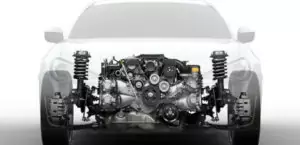Honda’s J37A 3.7-liter V6 engine was produced at a facility in the US from 2006 to 2014 and was installed in the largest and most expensive Legend sedan and many Acura models. This motor existed in five modifications, which did not differ much from each other.
The legendary J37 engine was released specifically for Acura cars. At the heart of the new engine was the J35, which performed well on the early larger Acura and Honda models from 1999 onwards. Both engines are united by V-blocks with a height of 235mm with six cylinders. Unlike the J35, which had a crankshaft with a piston stroke of 93mm, in the J37 this parameter was already equal to 96mm. The diameter of the cylinders increased by one millimeter, and became equal to 90mm. The connecting rods have been reduced from 158.5mm up to 157mm. The cylinder head on the J37 was single-shaft and with a variable valve timing and VTEC valve lift.
The J-series also includes internal combustion engines: J25A, J30A, J32A and J35A.
The engine was installed on:
- Acura MDX 2 (YD2) in 2006 – 2013;
- Acura RL 2 (KB) in 2008 – 2012;
- Acura TL 4 (UA8) in 2008 – 2014;
- Acura ZDX 1 (YB) in 2009 – 2013;
- Honda Legend 4 (KB) in 2008 – 2012.
Specifications
| Production years | 2006-2014 |
| Displacement, cc | 3664 |
| Fuel system | injector |
| Power output, hp | 295 – 305 |
| Torque output, Nm | 365 – 375 |
| Cylinder block | aluminum V6 |
| Block head | aluminum 24v |
| Cylinder bore, mm | 90 |
| Piston stroke, mm | 96 |
| Compression ratio | 11.0 – 11.2 |
| Features | SOHC |
| Hydraulic lifters | no |
| Timing drive | belt |
| Phase regulator | VTEC |
| Turbocharging | no |
| Recommended engine oil | 5W-30 |
| Engine oil capacity, liter | 4.3 |
| Fuel type | petrol |
| Euro standards | EURO 4/5 |
| Fuel consumption, L/100 km (for Honda Legend 2010) — city — highway — combined |
16.3 8.9 11.6 |
| Engine lifespan, km | ~320 000 |
| Weight, kg | 210 |
Disadvantages of the Honda J37A engine
- The engines of this family are famous for their reliability and have no weak points.
- Due to the low volume of oil in the system, you need to carefully monitor its level.
- The timing belt resource is approximately 100,000 km, when it breaks, the valve bends.
- The cause of floating motor speeds is usually throttle contamination.
- Every 50,000 km, valve adjustment is required, there are no hydraulic lifters here.






